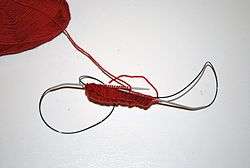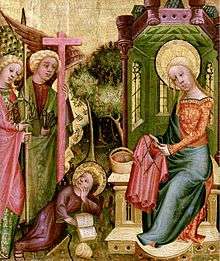Circular knitting



Circular knitting or knitting in the round is a form of knitting that creates a seamless tube. When knitting circularly, the knitting is cast on and the circle of stitches is joined. Knitting is worked in rounds (the equivalent of rows in flat knitting) in a spiral.[1] Originally, circular knitting was done using a set of four or five double-pointed needles. Later, circular needles were invented, which can also be used to knit in the round: the circular needle looks like two short knitting needles connected by a cable between them.
Longer circular needles can be used to produce narrow tubes of knitting for socks, mittens, and other items using the Magic Loop technique. Machines also produce circular knitting; double bed machines can be set up to knit on the front bed in one direction then the back bed on the return, creating a knitted tube.[2] Specialized knitting machines for sock-knitting use individual latch-hook needles to make each stitch in a round frame.[3]
Many types of sweaters are traditionally knit in the round. Planned openings (arm holes, necks, cardigan fronts) are temporarily knitted with extra stitches, reinforced if necessary. Then the extra stitches are cut to create the opening, and are stitched with a sewing machine to prevent unraveling.[4] This technique is called steeking.
Magic Loop technique
Invented by Sarah Hauschka and written in Beverly Galeska's booklet The Magic Loop, published by FiberTrends, the Magic Loop uses a 40-inch-long circular needle to knit projects of any circumference in the round. The key is pulling a loop of extra cable out between the stitches halfway through the round.
Using a 47-inch-long circular needle lets the knitter knit two-at-a-time projects, like two socks at once, using the Magic Loop method.
Notes
Further reading
- Zimmermann, Elizabeth. (1972). Knitting Without Tears. New York: Simon & Schuster. (Reprint Edition ISBN 0-684-13505-1)
- Rutt, Richard (2003). A History of Handknitting. Loveland, CO: Interweave Press. (Reprint Edition ISBN 1-931499-37-3)
- Hiatt, June Hemmons. (1989). The Principles of Knitting: Methods and Techniques of Hand Knitting. New York: Simon & Schuster. ISBN 978-0-671-55233-6
- Allen, Pam, Trisha Malcolm, Rich Tennant, and Cheryl Fall. (2002) Knitting for Dummies. New York: Hungry Minds, Inc. ISBN 978-0-7645-5395-0
- Breiter, Barbara, and Gail Diven (2003) The Complete Idiot's Guide to Knitting and Crocheting Illustrated, 2nd Edition. New York: Alpha Books. ISBN 978-1-59257-089-8
- KNITFreedom, Knitting in the Round on Magic Loop
External links
- "Large and Small Diameter Circular Knitting videos" from KnittingHelp
- "How to knit with one circular" from WeebleKnits
- "How to knit with two circulars" from WeebleKnits
- "How to knit small circumferences using one long circular needle" from WeebleKnits